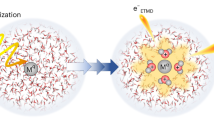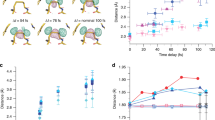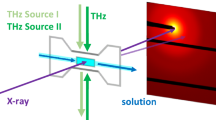Abstract
Metal centres in biomolecules are recognized as being particularly sensitive to radiation damage by X-ray photons. This results in such molecules being both susceptible to an effective X-ray-induced loss of function and problematic to study using X-ray diffraction methods, with reliable structures of the metal centres difficult to obtain. Despite the abundance of experimental evidence, the mechanistic details of radiation damage at metal centres are unclear. Here, using ab initio calculations, we show that the absorption of X-rays by microsolvated Mg2+ results in a complicated chain of ultrafast electronic relaxation steps that comprise both intra- and intermolecular processes and last for a few hundred femtoseconds. At the end of this cascade the metal reverts to its original charge state, the immediate environment becomes multiply ionized and large concentrations of radicals and slow electrons build up in the metal's vicinity. We conclude that such cascades involving metal ions are essential to our understanding of radiation chemistry and radiation damage in biological environments.
This is a preview of subscription content, access via your institution
Access options
Subscribe to this journal
Receive 12 print issues and online access
$259.00 per year
only $21.58 per issue
Buy this article
- Purchase on Springer Link
- Instant access to full article PDF
Prices may be subject to local taxes which are calculated during checkout


Similar content being viewed by others
References
Bertini, I., Gray, H. B., Stiefel, E. I. & Valentine, J. S. Biological Inorganic Chemistry (University Science Books, 2007).
Andreini, C., Bertini, I., Cavallaro, G., Holliday, G. & Thornton, J. Metal ions in biological catalysis: from enzyme databases to general principles. J. Biol. Inorg. Chem. 13, 1205–1218 (2008).
Strick, R., Strissel, P. L., Gavrilov, K. & Levi-Setti, R. Cation–chromatin binding as shown by ion microscopy is essential for the structural integrity of chromosomes. J. Cell Biol. 155, 899–910 (2001).
Wu, B. & Davey, C. A. Using soft X-rays for a detailed picture of divalent metal binding in the nucleosome. J. Mol. Biol. 398, 633–640 (2010).
Jawad, H. H. & Watt, D. E. Physical mechanism for inactivation of metallo-enzymes by characteristic X-rays. Int. J. Radiat. Biol. 50, 665–674 (1986).
Carugo, O. & Carugo, K. D. When X-rays modify the protein structure: radiation damage at work. Trends Biochem. Sci. 30, 213–219 (2005).
Yano, J. et al. X-ray damage to the Mn4Ca complex in single crystals of photosystem II. A case study for metalloprotein crystallography. Proc. Natl Acad. Sci. USA 102, 12047–12052 (2005).
George, S. J. et al. X-ray photochemistry in iron complexes from Fe(0) to Fe(IV)—can a bug become a feature? Inorg. Chim. Acta 361, 1157–1165 (2008).
Mesu, J. G., Beale, A. M., de Groot, F. M. F. & Weckhuysen, B. M. Probing the influence of X-rays on aqueous copper solutions using time-resolved in situ combined video/X-ray absorption near-edge/ultraviolet/visible spectroscopy. J. Phys. Chem. B 110, 17671–17677 (2006).
George, G. N. et al. X-ray-induced photo-chemistry and X-ray absorption spectroscopy of biological samples. J. Synchrotron Radiat. 19, 875–886 (2012).
Howell, R. W. Auger processes in the 21st century. Int. J. Radiat. Biol. 84, 959–975 (2008).
Gokhberg, K., Kolorenč, P., Kuleff, A. I. & Cederbaum, L. S. Site- and energy-selective slow-electron production through intermolecular Coulombic decay. Nature 505, 661–663 (2014).
Thürmer, S. et al. On the nature and origin of dicationic, charge-separated species formed in liquid water on X-ray irradiation. Nature Chem. 5, 590–596 (2013).
Cederbaum, L. S., Zobeley, J. & Tarantelli, F. Giant intermolecular decay and fragmentation of clusters. Phys. Rev. Lett. 79, 4778–4781 (1997).
Zobeley, J., Santra, R. & Cederbaum, L. S. Electronic decay in weakly bound heteroclusters: energy transfer versus electron transfer. J. Chem. Phys. 115, 5076–5088 (2001).
Jahnke, T. Interatomic and intermolecular Coulombic decay: the coming of age story. J. Phys. B 48, 082001 (2015).
Marsalek, O. et al. Chasing charge localization and chemical reactivity following photoionization in liquid water. J. Chem. Phys. 135, 224510 (2011).
Svoboda, O., Hollas, D., Oncak, M. & Slavíček, P. Reaction selectivity in an ionized water dimer: nonadiabatic ab initio dynamics simulations. Phys. Chem. Chem. Phys. 15, 11531–11542 (2013).
Jahnke, T. et al. Ultrafast energy transfer between water molecules. Nature Phys. 6, 139–142 (2010).
Barran, P. E., Walker, N. R. & Stace, A. J. Competitive charge transfer reactions in small [Mg(H2O)n]2+ clusters. J. Chem. Phys. 12, 6173–6177 (2000).
Pedersen, H. B. et al. Photolysis of water-radical ions H2O+ in the XUV: fragmentation through dicationic states. Phys. Rev. A 87, 013402 (2013).
Averbukh, V., Müller, I. B. & Cederbaum, L. S. Mechanism of interatomic Coulombic decay in clusters. Phys. Rev. Lett. 93, 263002 (2004).
Kolorenč, P., Averbukh, V., Gokhberg, K. & Cederbaum, L. S. Ab initio calculation of interatomic decay rates of excited doubly ionized states in clusters. J. Chem. Phys. 129, 244102 (2008).
Förstel, M., Mucke, M., Arion, T., Bradshaw, A. M. & Hergenhahn, U. Autoionization mediated by electron transfer. Phys. Rev. Lett. 106, 033402 (2011).
Sakai, K. et al. Electron-transfer-mediated decay and interatomic Coulombic decay from the triply ionized states in argon dimers. Phys. Rev. Lett. 106, 033401 (2011).
Stumpf, V., Kolorenč, P., Gokhberg, K. & Cederbaum, L. S. Efficient pathway to neutralization of multiply charged ions produced in Auger processes. Phys. Rev. Lett. 110, 258302 (2013).
Stumpf, V., Kryzhevoi, N. V., Gokhberg, K. & Cederbaum, L. S. Enhanced one-photon double ionization of atoms and molecules in an environment of different species. Phys. Rev. Lett. 112, 193001 (2014).
Pokapanich, W. et al. Ionic-charge dependence of the intermolecular Coulombic decay time scale for aqueous ions probed by the core-hole clock. J. Am. Chem. Soc. 133, 13430–13436 (2011).
Ohtaki, H. & Radnai, T. Structure and dynamics of hydrated ions. Chem. Rev. 93, 1157–1204 (1993).
Müller, I. B. & Cederbaum, L. S. Electronic decay following ionization of aqueous Li+ microsolvation clusters. J. Chem. Phys. 122, 094305 (2005).
Öhrwall, G. et al. Charge dependence of solvent-mediated intermolecular Coster–Kronig decay dynamics of aqueous ions. J. Phys. Chem. B 114, 17057 (2010).
Vendrell, O., Stoychev, S. & Cederbaum, L. S. Generation of highly damaging H2O+ radicals by inner valence shell ionization of water. ChemPhysChem 11, 1006–1009 (2010).
Pokapanich, W. et al. Auger electron spectroscopy as a probe of the solution of aqueous ions. J. Am. Chem. Soc. 131, 7264–7271 (2009).
Slavíček, P., Winter, B., Cederbaum, L. S. & Kryzhevoi, N. V. Proton-transfer mediated enhancement of nonlocal electronic relaxation processes in X-ray irradiated liquid water. J. Am. Chem. Soc. 136, 18170–18176 (2014).
Ottosson, N., Öhrwall, G. & Björneholm, O. Ultrafast charge delocalization dynamics in aqueous electrolytes: new insights from Auger electron spectroscopy. Chem. Phys. Lett. 543, 1–11 (2012).
Kryzhevoi, N. V. & Cederbaum, L. S. Using pH-value to control intermolecular electronic decay. Angew. Chem. Int. Ed. 50, 1306–1309 (2011).
Fasshauer, E., Förstel, M., Pallmann, S., Pernpointner, M. & Hergenhahn, U. Using ICD for structural analysis of clusters: a case study on NeAr clusters. New J. Phys. 16, 103026 (2014).
Tavernelli, I. et al. Time-dependent density functional theory molecular dynamics simulations of liquid water radiolysis. ChemPhysChem 9, 2099–2103 (2008).
O'Neill, P. in Radiation Chemistry: Present Status and Future Trends (eds Jonah, C. D. & Rao, B. S. M. ) (Elsevier Science B.V., 2001).
Gaigeot, M.-P. et al. A multi-scale ab initio theoretical study of the production of free radicals in swift ion tracks in liquid water. J. Phys. B 40, 1–12 (2007).
Alizadeh, E., Orlando, T. M. & Sanche, L. Biomolecular damage induced by ionizing radiation: the direct and indirect effects of low-energy electrons on DNA. Annu. Rev. Phys. Chem. 66, 379–398 (2015).
Takakura, K. Double-strand breaks in DNA induced by the K-shell ionization of calcium atoms. Acta Oncol. 35, 883–888 (1996).
Werner, H.-J. et al. Molpro, a general-purpose quantum chemistry program package. WIREs Comput. Mol. Sci. 2, 242–253 (2012).
Glendening, E. D. & Feller, D. Dication–water interactions: M2+(H2O)n clusters for alkaline earth metals M = Mg, Ca, Sr, Ba, and Ra. J. Phys. Chem. 100, 4790–4797 (1996).
Trofimov, A. B. & Schirmer, J. Molecular ionization energies and ground- and ionic-state properties using a non-Dyson electron propagator approach. J. Chem. Phys. 123, 144115 (2005).
Tarantelli, F. The calculation of molecular double ionization spectra by Green's functions. Chem. Phys. 329, 11–21 (2006).
Karlström, G. et al. Molcas: a program package for computational chemistry. Comp. Mat. Sci. 28, 222–239 (2003).
Guest, M. F. et al. The GAMESS-UK electronic structure package: algorithms, developments and applications. Mol. Phys. 103, 719–747 (2005).
Averbukh, V. & Cederbaum, L. S. Ab initio calculation of interatomic decay rates by a combination of the Fano ansatz, Green's function methods, and the Stieltjes imaging technique. J. Chem. Phys. 123, 204107 (2005).
Kryzhevoi, N. V., Averbukh, V. & Cederbaum, L. S. High activity of helium droplets following ionisation of systems inside those droplets. Phys. Rev. B 76, 094513 (2007).
Acknowledgements
The authors thank N. V. Kryzhevoi, S. Klaiman, E. V. Gromov and P. Kolorenč for discussions and technical advice. Financial support of the Deutsche Forschungsgemeinschaft (FOR 1789 ‘Interatomic Coulombic Decay’) is acknowledged.
Author information
Authors and Affiliations
Contributions
V.S., K.G. and L.S.C. conceived the idea of electronic cascades in metal–ion complexes. V.S. and K.G. carried out the computations. V.S., K.G. and L.S.C. analysed the results and wrote the paper.
Corresponding author
Ethics declarations
Competing interests
The authors declare no competing financial interests.
Supplementary information
Supplementary information
Supplementary information (PDF 268 kb)
Rights and permissions
About this article
Cite this article
Stumpf, V., Gokhberg, K. & Cederbaum, L. The role of metal ions in X-ray-induced photochemistry. Nature Chem 8, 237–241 (2016). https://doi.org/10.1038/nchem.2429
Received:
Accepted:
Published:
Issue Date:
DOI: https://doi.org/10.1038/nchem.2429
This article is cited by
-
Radiation damage by extensive local water ionization from two-step electron-transfer-mediated decay of solvated ions
Nature Chemistry (2023)
-
Hot spots of radiation damage from extensive water ionization around metal ions
Nature Chemistry (2023)
-
Triple ionization and fragmentation of benzene trimers following ultrafast intermolecular Coulombic decay
Nature Communications (2022)
-
Multiscale simulation of the focused electron beam induced deposition process
Scientific Reports (2020)
-
Highly efficient double ionization of mixed alkali dimers by intermolecular Coulombic decay
Nature Physics (2019)



